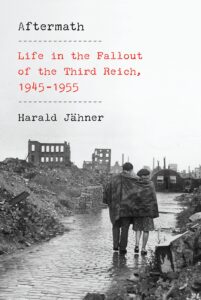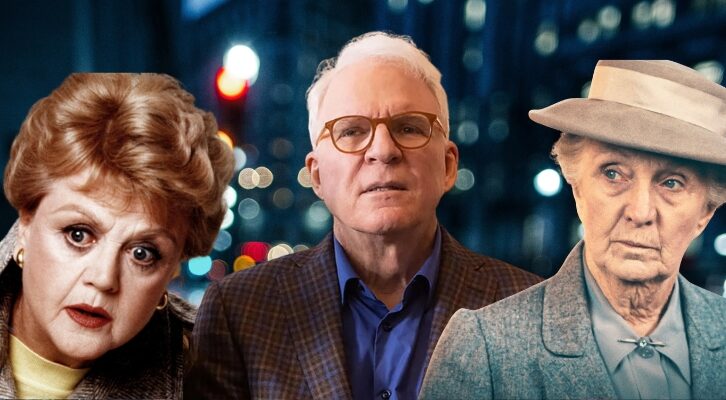
What Was Germany Like in the Decade After Hitler?
Harald Jähner on the No Man’s Time of Post WWII Germany

From this year’s Cundill History Prize shortlisted title Aftermath: Life in the Fallout of the Third Reich by Harald Jähner.
On March 18, 1952 the Neue Zeitung published an article by the author and editor Kurt Kusenberg entitled “Nothing can be taken for granted: Praise for a time of misery.” Only seven years on, the author yearned for the weeks of confusion that had followed the end of the Second World War in Germany. Even though nothing had worked at the time—not the postal service, the railways, public transport—in spite of the homelessness, the hunger and the occasional corpse that still lay buried under the rubble, in retrospect those weeks struck him as having been a good time. “Like children,” he wrote, people after the war had begun “to mend the torn net of human relationships.” His choice of words is unusual and perhaps a little disconcerting . . . “Like children”?
Kusenberg urgently recommended that his readers imagine themselves back into the “starving, tattered, shivering, poverty-stricken, dangerous time” when, in the absence of state order, morality and social connections were redefined among the scattered people:
Respectability did not exclude resourcefulness and cunning—not even the petty theft of food. But in this semi-larcenous life there was an honor among thieves that was perhaps more moral than today’s cast-iron conscience.
It is a strange nostalgia. Was there really supposed to have been so much adventure immediately after the war, so much “honor among thieves”? So much innocence? The unifying force that had held the Germans together until the end of the war had been—fortunately—completely ruptured. The old order was gone, a new one was written in the stars, and for now the Allies supplied the basic necessities needed to maintain the population. The 75 million or so people collected on what remained of German soil in the summer of 1945 hardly merited the name of a society. People talked about “no man’s time,” the “time of the wolves” in which “man had become a wolf towards his fellow man.” The ethos of everyone caring only for themselves or their wolf-pack shaped the country’s national identity until deep into the 1950s, by which point conditions had been improving for some time and yet despite this people still stubbornly withdrew into their families as self-contained refuges.
After the war over half the population of Germany were neither where they belonged nor wanted to be, including 9 million bombed-out people and evacuees, 14 million refugees and exiles, 10 million released forced laborers and prisoners, and countless millions of slowly returning prisoners of war. How was this horde of ragged, displaced, impoverished and leftover people broken up and reassembled? And how did former “national comrades” (Volksgenossen), as German nationals were known under Nazism, gradually become ordinary citizens again?
These are questions that threaten to disappear under the weight of momentous historical events. The most important changes were played out in everyday life, in the organization of food, for example, in looting, money-changing, shopping. And also in love, as a wave of sexual adventurousness followed the war. There was some keen disappointment when much-missed husbands failed to return home, but, equally, many Germans now saw things with different eyes, they wanted to start everything afresh, and divorce rates leapt.
The collective memory of the post-war age in Germany is shaped by a few images that have etched their way deeply into people’s minds: the Russian soldier pulling a woman’s bicycle out of her hands; dim black-market figures clustering around a few eggs; the temporary Nissen huts housing refugees and people whose houses had been bombed; the women questioningly holding up photographs of their missing husbands to the returning prisoners of war. These few pictures are so visually powerful that they imprinted on the German public memory of the first post-war years like an unchanging silent film—although, it must be said, half of life ends up on the cutting-room floor.
While memory usually bathes the past in a softer light with the passing years, the reverse is true for the post-war period in Germany. In hindsight it became increasingly dark. One reason for that lies in the widespread need among Germans who had not been persecuted by the Nazi regime to see themselves, nevertheless, as victims. Many people clearly felt that the grimmer the accounts of the genuinely terrible starving winters of 1946 and 1947, the more their guilt was diminished. But if we listen carefully we can also hear laughter. A spontaneous Rosenmontag (Rose Monday) carnival procession passed through a terribly depopulated Cologne as early as 1946. The journalist Margret Boveri remembered the feeling of life being “enormously enhanced by the approaching nearness of death.” In the years when there was nothing to buy she had been so happy that she later decided not to undertake any major purchases even when times improved.
Misery cannot be understood without the pleasure that it provokes. Escaping death drove some into apathy, others into a passionate love of life. The old order of things had gone off the rails, families had been torn apart, connections lost—but people were starting to mingle again, and anyone young and spirited saw the chaos as a playground in which they had to seek their joy anew each day.
The Holocaust played a shockingly small part in the consciousness of most Germans in the post-war period. Some were aware of the crimes on the Eastern Front, and a certain fundamental guilt at having started the war in the first place was acknowledged, but there was no room in many people’s thoughts and feelings for the murder of millions of German and European Jews. Only a very few individuals, such as the philosopher Karl Jaspers, addressed the issue publicly. The Jews were not even explicitly mentioned in the much-debated admissions of guilt by the Protestant and Catholic Churches in August 1945.
In a perfidious way the unthinkability of the Holocaust also extended to the nation that had perpetrated it. The crimes had an enormity which banished them from the collective consciousness even while they were happening. The fact that even well-intentioned people refused to think about what would happen to their deported neighbors has left trust in the human species severely shaken even into the present day. And the majority of Germans at the time were guilty of this.
The hushing-up of the extermination camps continued after the end of the war, even though the Allies tried to forcibly confront the defeated German people with evidence of Nazi crimes. Post-war Chancellor Helmut Kohl used the sardonic phrase “the blessing of late birth” to suggest that the younger generation had no right to feel quite so superior to the one that came before. But there was also the blessing of the experience of terror. The nights of bombing raids, the harsh starvation winters of the first post-war years and the sheer struggle for survival under anarchic everyday conditions kept many Germans from thinking about the past. They saw themselves as the victims, and thus had the dubious good fortune of not having to think about the real ones. Because, had they still been halfway decent after all that had happened, had they been aware of the systematic mass murder committed in their name, with their tacit support and thanks to their willingness to turn a blind eye, they would hardly have been able to summon the courage and energy required to live through the post-war years.
The survival instinct shuts out feelings of guilt—a collective phenomenon that can be studied in the years after 1945 and must be deeply unsettling to anyone with faith in humanity.
The survival instinct shuts out feelings of guilt—a collective phenomenon that can be studied in the years after 1945 and must be deeply unsettling to anyone with faith in humanity. But how the two societies of East and West Germany, both anti-fascist in their different ways, could both be founded on repression and distortion is a mystery that Aftermath: Life in the Fallout of the Third Reich seeks to address by immersing itself in the extreme challenges and curious lifestyles of the post-war years.
Even though books like Anne Frank’s Diary or Eugen Kogon’s SS-State disrupted the process of repression, it was only with the Auschwitz trials beginning in 1963 that many Germans began to reckon with the crimes that had been committed in their name. In the eyes of the younger generation the Germans had brought extreme dishonor upon themselves by postponing the trials, even though in purely material terms they had profited considerably from their parents’ capacity for repression. Seldom in history has a generational conflict been waged with more bitterness, rage and self-righteousness than that of the young German people of 1968 against their parents.
Today, the German people’s overall impression of the post-war years has been shaped by the perspective of those who were young at the time. The anti-authoritarian fury the children felt towards their parents’ generation—a generation that had not made itself easy to love—was so intense, their criticism so eloquent, that the myth of a suffocating layer of fustiness that needed to be eliminated still dominates the image of the 1950s held by most Germans, in spite of more sophisticated historical research. The generation born around 1950 enjoyed the role of having made the Federal Republic (West Germany) inhabitable and having given democracy a heart, and this generation continues to promulgate that picture. In reality, though, there remained a strong presence of the old Nazi elite in the offices of the Federal Republic during this time, which was a source of revulsion for many, as was the readiness with which Nazi criminals were granted amnesties. However, the post-war era in Germany was more exciting, its sense of life more open, its intellectuals more critical, its spectrum of opinion broader, its art more innovative, and its every-day life more contradictory than the impressions that have prevailed from 1968 until the present day might suggest.
There is another reason why the first four post-war years in Germany represent a relative blind spot in historical memory. Between the big chapters and research headings of history they form a kind of no man’s time for which, loosely speaking, no one is really responsible. One major chapter in German school history deals with the Nazi regime, ending with the capitulation of the German Wehrmacht, while the next, which begins in 1949, tells the story of the Federal Republic of Germany (West Germany) and the German Democratic Republic (East Germany) and is concentrated at best on currency reform and the Berlin blockade as a backstory to the foundation of the two states. The years between the end of the war and the currency reform, the economic Big Bang of the Federal Republic, are in a sense a lost time for historiography, because they lack an institutional subject. German history-writing is essentially still structured as a national history, which places the state as a political subject at its centre. But from 1945 four political centers were responsible for German history: Washington, Moscow, London and Paris, each exercising authority over their designated occupation zone—hardly ideal conditions to construct a national history.
The classroom appraisal of the crimes perpetrated against the Jews and forced laborers also ends, as a rule, with the happy liberation of the survivors by Allied soldiers. But what happened to them after that? What about the 10 million or so starving prisoners, already dragged from their homelands and now dumped unsupervised in the land of their torturers and murderers? How did they react? The way the Allied soldiers, the vanquished Germans and the liberated forced laborers behaved towards one another is one of the saddest, but also one of the most fascinating, aspects of the post-war years.
Throughout Aftermath, the focus shifts from the societal aspects of everyday life—from clearing up, making love, stealing and shopping—to the cultural features: the life of the mind and the efflorescence of a radical new visual aesthetic. Here, questions of conscience, guilt and repression are asked more pointedly. Instances of denazification, which also had its aesthetic side, are treated with appropriate care. The fact that the arts (broadly taken to mean architecture, painting, etc.) of the 1950s found such lasting fame may be traced back to one surprising factor: by altering their surroundings the Germans changed themselves. But was it really the Germans who so radically transformed the shape of their world? A fight broke out around concepts of design and abstract art, in which the occupying powers of America, Britain, France and Russia all pulled strings; it concerned the aesthetic decoration of the two German republics, pitting the socialist realism of the East against the abstract art of the West, and would define the sense of beauty during the Cold War. Even the CIA was involved.
Even more than is the case today, German people tended to present themselves as refined, sophisticated and tirelessly involved in serious discussions, as if it were possible to pick up seamlessly from the manners of the nineteenth century, which had been transformed into “the good old days.” Today we know a great deal about the Holocaust. What we know less about is how life in Germany continued under the shadow it cast across the country’s future. How does a nation in whose name many millions of people were murdered talk about culture and morality? Would it be better, for decency’s sake, to avoid talking about decency altogether? To let one’s children find out for themselves what is good and what is evil? In the years immediately following the war analysts in the media were working overtime, along with other institutions, to take part in the reconstruction of society. Everybody was talking about a “hunger for meaning.” Philosophizing on “the ruins of existence” meant searching for meaning, just as many were reduced to searching for scraps among the rubble.
_______________________________

From Aftermath: Life in the Fallout of the Third Reich by Harald Jähner, published by Ebury in the UK and Knopf in the US. Used with permission of the publisher. Copyright 2022 by Harald Jähner, translation copyright 2022 by Shaun Whiteside.
Harald Jähner
Harald Jähner is a cultural journalist and former editor of the Berliner Zeitung. He was also an honorary professor of cultural journalism at the Berlin University of the Arts. His book Aftermath: Life in the Fallout of the Third Reich was shortlisted for the Cundill History Prize and the Baillie Gifford Prize for Non-Fiction. He lives in Germany.



















